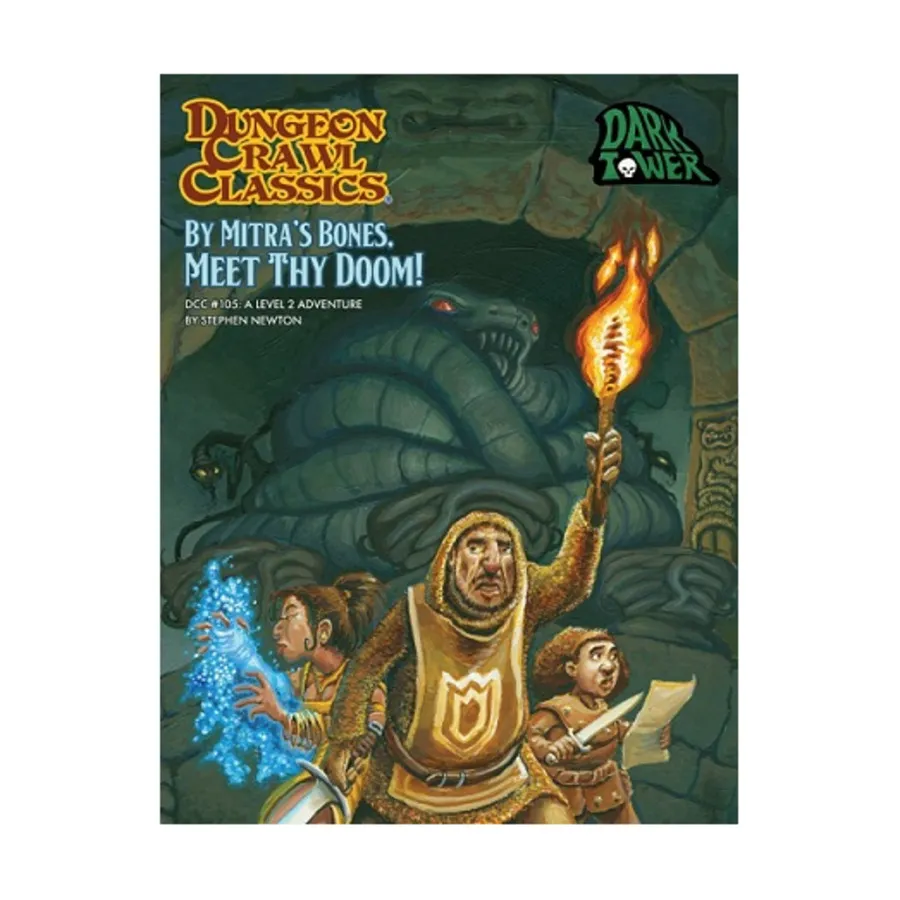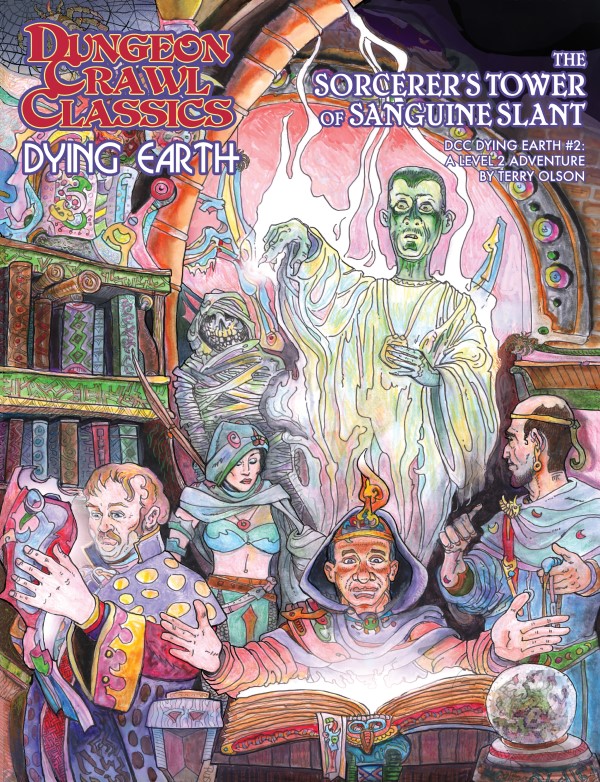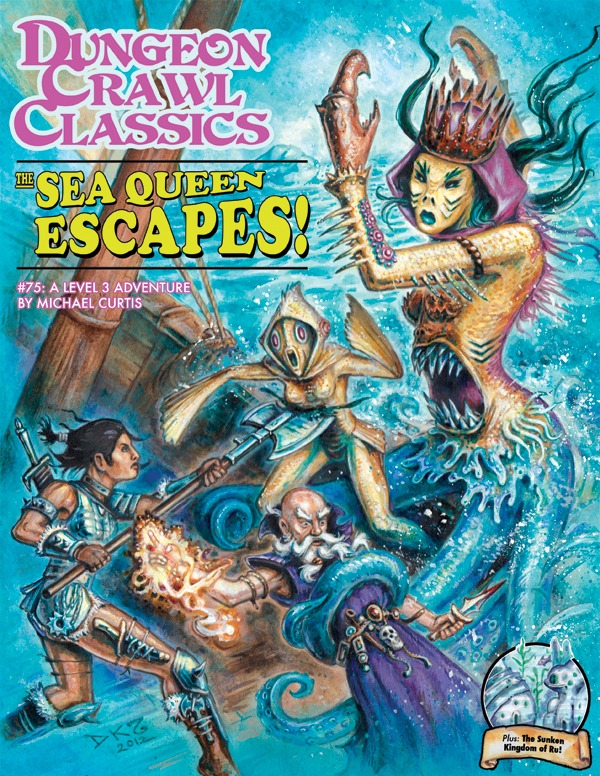For part 2 of this 2-part article series, and as DCC Day–July 20th–approaches, let’s take a deeper dive into Goodman Games’ Dungeon Crawl Classics (DCC) RPG system and its wonderfully strange settings, from the crime-ridden streets of Lankhmar to the post-apocalyptic, radiation–soaked Mutant Crawl Classics.
Did you miss part one of this article series? Well, you can find it right here!
DCC: Sword and Sorcery with a side of Dice
It is a truth universally acknowledged that an RPG in possession of good bones must be in want of adventures. Goodman Games’ Dungeon Crawl Classics line is just that, a slimming down of sourcebooks, rules, and focus to get to the best parts: monsters, mayhem, and making memories.
 Taking its inspiration, sometimes with direct updates, from early RPGs in the 1970s, the DCC system runs on simplicity and open play, letting you jump into the shoes of a secretive warlock, a conniving rogue, or a mutated terror intent on slobbering your way through humanity’s remnants (more on that one later), or just about anything else. The key difference between DCC and most other RPGs is, for lack of a better word, vibe.
Taking its inspiration, sometimes with direct updates, from early RPGs in the 1970s, the DCC system runs on simplicity and open play, letting you jump into the shoes of a secretive warlock, a conniving rogue, or a mutated terror intent on slobbering your way through humanity’s remnants (more on that one later), or just about anything else. The key difference between DCC and most other RPGs is, for lack of a better word, vibe.
You’re gonna go on an adventure, you’re gonna battle some monsters, roll some dice, and save the day or die trying. And it’s going to be a blast.
DCC puts your session on skates, with level 0 funnel adventures meant to kick things off and potentially kill early characters, leaving you and your playgroup with the survivors. Those hardy folks, having made it this far, get to use their scars, personality, and memories to inform their classes, skills, and role-playing traits. Players aren’t asked to assemble a whole backstory at the outset, instead diving in and building up their characters narratively, in the action.
The usual classes, spells, swords, and all that jazz are present in DCC, with traits like Will and Fortitude around for skill checks. Luck acts as an actual resource, spent to boost a critical roll or earned for clever play. A partner app, The Crawler’s Companion, sits nearby to pull up a needed reference table in a hot second, keeping you focused on the action rather than paging through a sourcebook pile. In short, when you sit down for a DCC game, you’ll be playing almost from the outset, rather than burying your hours in paperwork.
But what, really, does play look like?
I mentioned those level 0 funnels, adventures deliberately designed to winnow a starting group, like a horde of peasants charging in after a neighborhood vampire, into an adventuring party. These one-shots lead to others, which can become campaigns, many of which Goodman Games has updated from their original sword and sorcery origins. Driving all of this are tables and dice rolls, many leading to wild results, such as a catastrophic spell failure that has the dungeon collapsing all around you. Anyone can try to search for traps, no specific skills needed, but if your bumbling fighter flubs their search, they might find themselves losing a leg.
The Dungeon Crawl Classics system leans into pulpy story. Characters can and will die. Astounding, over-powered moments can and will occur. You will laugh when your thief blows their roll and a chest explodes, or the sinister demon gets blitzed by a furious, luck-buffed assault from your carpenter-turned-fighter, making an all-out heroic attack to earn a victory.
Giving DCC a try is simple: stop in at Noble Knight or your local participating store for DCC Day and grab a Quick Start bundle. That’ll take a set of characters from level 0 to 2 and teach you whether this is a format you’ll want to keep on playing. From there, you can either grab a core rulebook or get the First Time Fan Kit from Goodman Games themselves. There’s also a PDF version if you prefer your books done digitally.
characters from level 0 to 2 and teach you whether this is a format you’ll want to keep on playing. From there, you can either grab a core rulebook or get the First Time Fan Kit from Goodman Games themselves. There’s also a PDF version if you prefer your books done digitally.
Once you’ve fallen in love with the action-driven questing on offer here, take a look at all the adventure modules, published both by Goodman Games and numerous others. Many update favorite tales, like Dark Tower or The Crypt of the Devil Lich into modern, beautiful new books. They’re all great fun, and a nimble GM can be assured of fast-paced sessions buttressed by pulpy, classic writing. The price point is perfect too: you’ll be supporting writers and artists without blowing the bank on expensive editions (though those exist if bling is more your thing).
If a sword and sorcery RPG built for player-driven adventure is what you’re looking for, then Dungeon Crawl Classics ought to be your next stop.
Beyond Fantasy: DCC’s Wild Worlds
Much like 5E, the Dungeon Crawl Classics system is eminently portable, and Goodman Games has a couple of flagship worlds (think Forgotten Realms or Eberron of D&D fame) for campaigns to explore.
 First up is Dungeon Crawl Classics: Lankhmar, licensed from the estate of author Fritz Lieber to bring you to the City of the Black Toga, so named for the smoke enveloping much of the place. If you’re looking for juicy urban adventures, rife with thievery, corruption, and nefarious villains skulking in the shadows, Lankhmar’s the place to ground your DCC story.
First up is Dungeon Crawl Classics: Lankhmar, licensed from the estate of author Fritz Lieber to bring you to the City of the Black Toga, so named for the smoke enveloping much of the place. If you’re looking for juicy urban adventures, rife with thievery, corruption, and nefarious villains skulking in the shadows, Lankhmar’s the place to ground your DCC story.
Getting started with Lankhmar is a snap, with Goodman Games offering a box set kit stuffed with maps, special rules, setting details, and the starting adventure No Small Crimes in Lankhmar.
If you prefer a campaign with a little more horror, a little more supernatural elements, then take your doomed heroes to the Shudder Mountains. Described as ‘Appalachian Fantasy’ and based on the works of author Manly Wade Wellman, the Shudder Mountains and adventures like The Chained Coffin bring your players into chilling contact with supernatural terrors like witches, devils, and the IRS (okay, maybe not the last, but they’d fit right in). Unlike Lankhmar, Shudder Mountains lives among the plethora of places DCC lets you set your campaigns, but without big starter kits or mountains (heh) of material. Instead, you can turn to the thriving community for adventures, resources, and ideas.
DCC is a thriving system, one ready to handle your best stories, or your weirdest, which brings us to a riff on DCC, a wonderful, strange beast known as Mutant Crawl Classics.
A Post-Apocalypse RPG with a side of Everything
If Dungeon Crawl Classics brings classic sword and sorcery to the table, then Mutant Crawl Classics (MCC) transports the same gonzo, free-wheeling play to a post-apocalyptic world where zany artifacts, robots, and blade-wielding bugs are on the loose. You might go on a quest to find long lost knowledge, or trek through radiation-soaked forests to stop some mad scientist from unleashing terrible technology, or perhaps defend the same against ravenous mutated horrors.
Who, after all, doesn’t love a good mutated horror?
Mutant Crawl Classics has numerous adventures of its own, kicking off with a core rulebook that adopts DCC’s principles, including a level 0 funnel to weed out your more pitiful peasants from promising adventurers. From there, you can bring your group through campaigns or one-shots, with some simply incredible ideas that read like B-Movie plots:
Incursion of the Ultradimension: A stone gateway rises and unleashes alien terrors, dare you step through and see what waits beyond?
Data Orb of Metakind: Dare you seek out and touch an ancient artifact flush with knowledge, even if all that knowledge comes with a dire price?
Mayhem on the Magtrain: Who needs Murder on the Orient Express when you can put your players on a train let loose by a maniacal robotic conductor? It’s like Snowpiercer and Terminator joined forces just for your entertainment.
DCC and MCC are cross-compatible too, meaning that you can easily port your favorite DCC adventures into the post-apocalyptic setting. Want to make a Devil Lich even scarier? Make them radioactive and give’em a laser cannon.
Other than the rule book, Mutant Crawl Classics also has starter kits, containing beginner adventures, screens, dice and all you need to jump right in. Like DCC, this isn’t a system that requires a library to understand, and its dice-chucking tables keep things entertaining and zipping along.
If you’re looking for pulpy post-apocalyptic adventure, Mutant Crawl Classics is worth a three-eyed look.
DCC Day is your first step into a wider, weirder RPG World
Sometimes all you want is to gather your pals around the table and tell an action-packed story. One flush with monsters, hideous evil, and zero-to-hero adventure. Dungeon Crawl Classics and its sister settings offer just that, keeping the story moving with swords and sorceries rather than reams of skill-specific stat tracking or reference manual lookups. With starter kits and plenty of published modules, including the quick start guides available on July 20th for DCC Day, Dungeon Crawl Classics is an RPG worth bringing to your table.
Just hope your dice are up to the challenge.
Interested in reading more about Goodman Games? Check out this article covering all the other wonderful things Goodman Produces.
